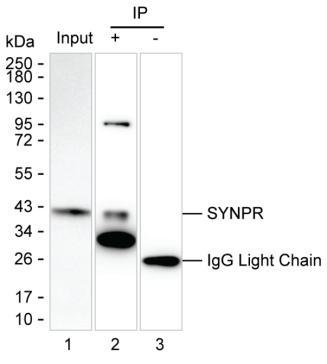

| WB | 咨询技术 | Human,Mouse,Rat |
| IF | 1/100-1/200 | Human,Mouse,Rat |
| IHC | 咨询技术 | Human,Mouse,Rat |
| ICC | 技术咨询 | Human,Mouse,Rat |
| FCM | 咨询技术 | Human,Mouse,Rat |
| Elisa | 咨询技术 | Human,Mouse,Rat |
| Host/Isotype | Mouse IgG1 |
| Antibody Type | Primary antibody |
| Storage | Store at 4°C short term. Aliquot and store at -20°C long term. Avoid freeze/thaw cycles. |
| Species Reactivity | Human, Rat |
| Immunogen | Purified recombinant fragment of human SYNPR |
| Formulation | Purified antibody in PBS with 0.05% sodium azide |
+ +
以下是关于SYNPR(Synaptoporin)抗体的3篇代表性文献的简要信息,涵盖其在神经科学领域的研究应用:
---
1. **文献名称**:*Synaptoporin is a major component of the synaptic vesicle membrane*
**作者**:Takamori S, et al.
**摘要概括**:该研究首次报道了SYNPR(Synaptoporin)作为突触小泡膜的关键成分,利用特异性抗体进行免疫标记,揭示了其在大脑不同区域(如海马)中的分布差异,并提示其在突触传递中的潜在功能调控作用。
---
2. **文献名称**:*Array tomography: A new tool for imaging the molecular architecture and ultrastructure of neural circuits*
**作者**:Micheva KD, et al.
**摘要概括**:本文开发了阵列断层扫描技术,结合多种突触蛋白抗体(包括SYNPR抗体),实现了对突触超微结构和分子组成的超高分辨率成像,为解析突触多样性及神经环路连接提供了重要工具。
---
3. **文献名称**:*RIM proteins tether Ca²⁺ channels to presynaptic active zones via a direct PDZ-domain interaction*
**作者**:Schoch S, et al.
**摘要概括**:研究通过SYNPR抗体与其他突触前标记物的共定位分析,揭示了RIM蛋白与电压门控钙通道的相互作用机制,强调了SYNPR在突触前活性区组织及神经递质释放调控中的辅助作用。
---
**备注**:SYNPR抗体的研究多聚焦于突触可塑性、神经发育及疾病模型(如阿尔茨海默病)。如需更近期文献,建议在PubMed中检索关键词“Synaptoporin antibody”并筛选应用类文章。
SYNPR (Synaptoporin) antibodies are essential tools in neuroscience research, specifically targeting the SYNPR protein, a member of the synaptophysin family. Synaptoporin is a synaptic vesicle membrane protein predominantly expressed in specific neuronal subpopulations, such as hippocampal neurons. It plays a role in synaptic vesicle trafficking, neurotransmitter release, and synaptic plasticity, which are critical for learning and memory processes. Structurally, SYNPR shares homology with synaptophysin, featuring four transmembrane domains, but exhibits distinct expression patterns and functional roles.
SYNPR antibodies are widely used to study synaptic architecture and function in both normal and pathological conditions. They enable detection and localization of SYNPR via techniques like Western blotting, immunohistochemistry, and immunofluorescence, aiding in the exploration of synaptic alterations in neurodegenerative diseases (e.g., Alzheimer’s) and psychiatric disorders (e.g., schizophrenia). Research has linked SYNPR dysregulation to impaired synaptic communication, making it a potential biomarker for synaptic dysfunction.
The development of SYNPR antibodies has advanced understanding of synapse-specific mechanisms, particularly in glutamatergic and GABAergic systems. Their specificity allows researchers to differentiate SYNPR from other synaptophysin-family proteins, clarifying its unique contributions to synaptic physiology. Overall, SYNPR antibodies are pivotal in elucidating synaptic pathology and developing targeted therapeutic strategies for neurological and psychiatric conditions.
×